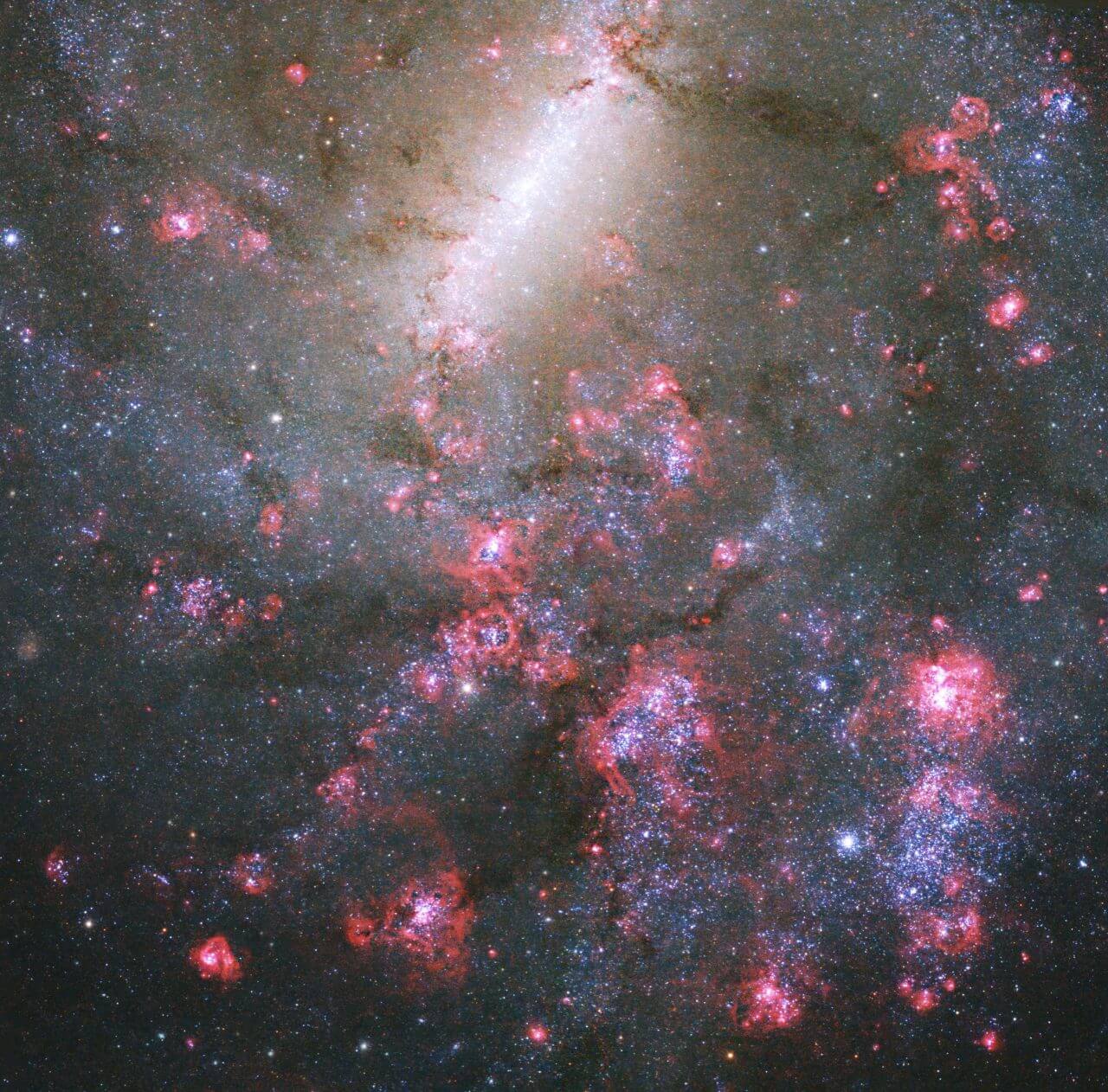This is NGC 5068, a barred spiral galaxy located about 20 million light-years away in the constellation Virgo. At the top of the image, there is a bright ribbon-like structure in the center where stars are densely packed, spiral arms colored blue by young stars spread across the field of view.
[▲Baredspiralgalaxy“NGC5068”imagedbyaspacetelescope(Credit:NASAESARichard(UniversityofToledo)andGLEI(SpaceTelescopeScienceInstitute);Processing:Gladyskopper(NASA/Catholic)AmericanUniversity))】[▲المجرةالحلزونيةذاتالقضيب”NGC5068″التيتمتصويرهابواسطةتلسكوبهابلالفضائي(الائتمان:ناسا،وكالةالفضاءالأوروبية،رتشاندار(جامعةتوليدو)،وجلي(معهدعلومالتلسكوبالفضائي)؛المعالجة:جلاديسكوبر(ناسا/كاثوليكية)الجامعةالأمريكية)))】
The red region that looks like many roses in full bloom is the HII region, where hydrogen gas ionized by ultraviolet radiation from a young, massive star emits light. The HII region is also a star-forming region where stars form from gas and dust, and is sometimes called the “cradle of stars” because it is the location where new stars are born.
According to the National Aeronautics and Space Administration (NASA), at least 110 stars of a type called Wolf-Rayet stars have been found in NGC 5068. A Wolf-Rayet star is an evolved form of a massive O-type star, which is nearing the end of its short lifespan. It is about 10 million years old or less. The high-temperature inner layers of Wolf-Rayet stars are thought to be exposed due to large amounts of hydrogen being emitted from the star’s outer layers and lost in the stellar wind. A typical Wolf-Rayet star is said to have a mass 25 times that of the Sun and a brightness up to a million times that of the Sun, about 220 of which have been found in the Milky Way.
This image was created based on data (using ultraviolet, visible and near-infrared filters) acquired by the Hubble Space Telescope’s (HST) Wide Field Camera 3 (WFC3), published by NASA on October 6, 2023. Incidentally, NGC 5068 was also observed by the James Webb Space Telescope (JWST) as part of a study to identify star formation in regions of gas in nearby galaxies, and the image was released in June 2023.
RELATED: Near the center of barred spiral galaxy ‘NGC 5068’ in the constellation Virgo observed by the Webb Space Telescope (June 10, 2023)

[▲AdiagramshowingthepanoramicimageofthebarredspiralgalaxyNGC5068(bottomleft)therangeintheHubbleSpaceTelescopeimage(topright)andtherangeintheGTSimage(bottomright)(Imagecredit:NASAESARChandar(UniversityofToledo)andJLee(STScI);Processing:Gladyscober)NASA/TheCatholicUniversityofAmerica)DECamVictorMBlanco/CTIO(CSAJLeeandPHANGS-JWSTTeam)】[▲رسمتخطيطييوضحالصورةالشاملةللمجرةالحلزونيةالقضيبية”NGC5068″(أسفلاليسار)،ومدىالصورةالملتقطةبواسطةتلسكوبهابلالفضائي(أعلىاليمين)،ومدىالصورةالملتقطةبواسطةتلسكوبجيمسويبالفضائيالتلسكوب(أسفلاليمين)(مصدرالصورة:NASA،ESA،RChandar(جامعةتوليدو)،وJLee(STScI)؛المعالجة:غلاديسكوبر(NASA/الجامعةالكاثوليكيةالأمريكية)،DECam،VictorMBlanco/CTIO،CSA،JLeeوفريقPHANGS-JWST)】
source
- NASA – Hubble’s multi-wavelength view of the recently released Webb image
Text Editing/Syrian Studies Department

“Travel maven. Beer expert. Subtly charming alcohol fan. Internet junkie. Avid bacon scholar.”







More Stories
The ranking of the best survival horror games selected by the IGN US editorial team has been released! Resident Evil RE:2 ranked first
Enjoy a hot cigarette while looking at whales and tropical fish under the sea ⁉︎ “Ploom Dive” is an amazing spatial video experience using Apple Vision Pro
Apple Watch now supports sleep apnea, watchOS 11 released – Impress Watch